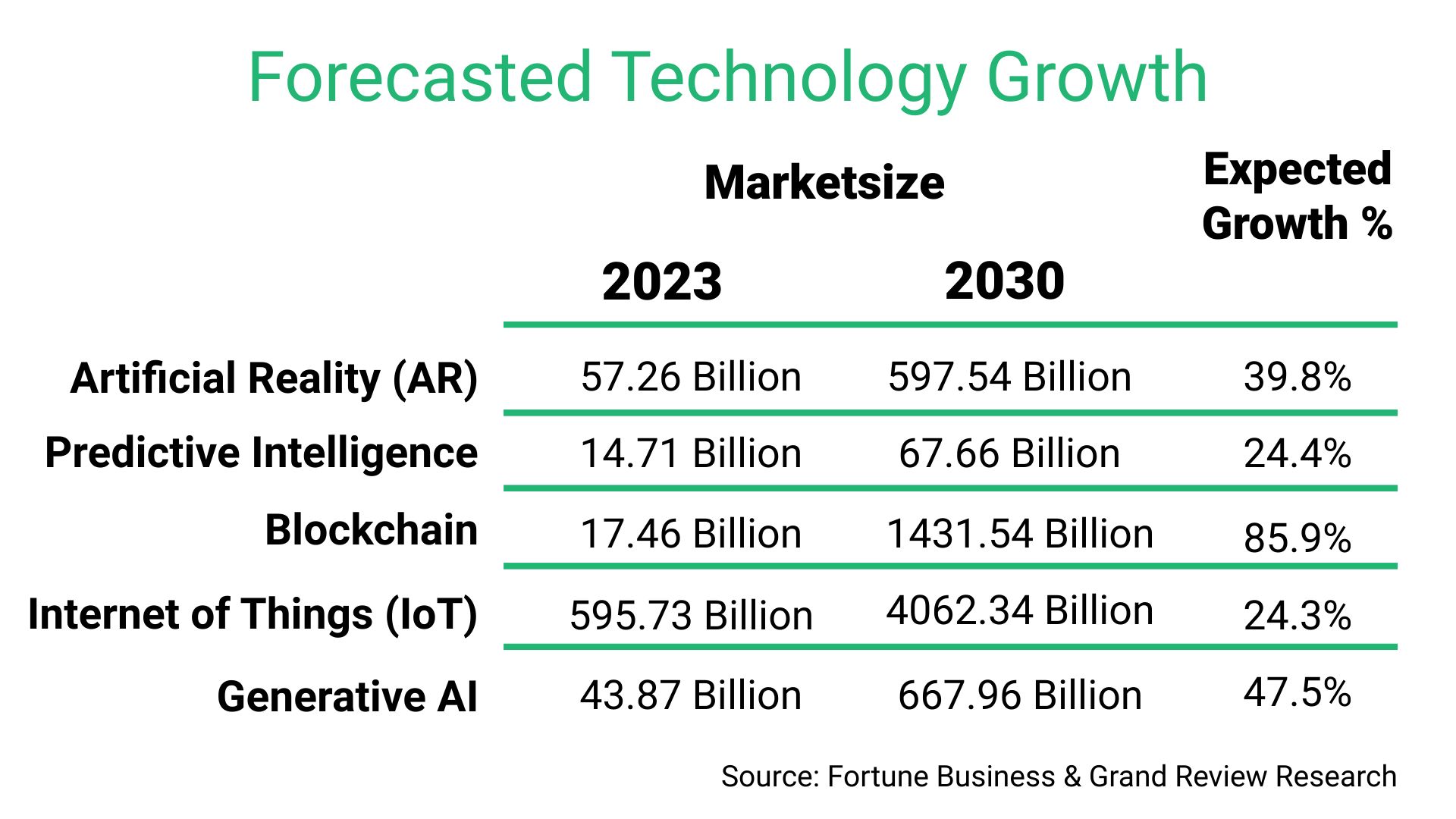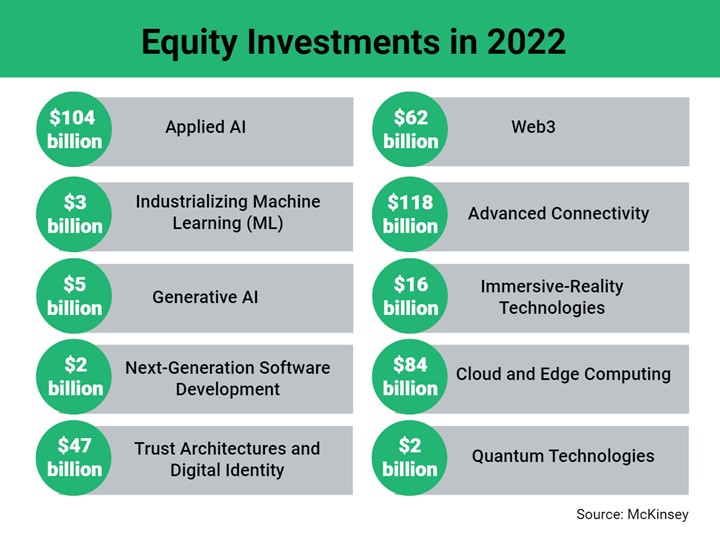
Are you tired of constantly struggling to keep up with emerging technology trends? Do you feel like you are always one step behind your competitors? If so, you are not alone. In the ever-evolving business environment, staying ahead of the curve can be a real challenge, but it is essential if you want to achieve success.
As a business leader, you are always on the lookout for ways to supercharge productivity, efficiency, and profitability. It is practically in your job description. Fortunately, there are a few key technologies, like AI/ML, IoT, Predictive Intelligence, Cloud Computing, Blockchain Technology, etc., that you can leverage to stay ahead of the curve and achieve your goals. But here is the conundrum: with new emerging technology trends sprouting up every day, how do you know which ones are the real game-changers? Well, let’s take a look at the pivotal role of emerging technology trends in reshaping industries and how businesses can adapt to thrive in this rapidly evolving landscape.
The Ever-Changing Landscape of Emerging Technology Trends
 Embracing emerging technology trends is no longer an option; it's a prerequisite for sustaining competitiveness and relevance in the ever-evolving digital landscape. The business arena is in a constant state of flux, and those who fail to adapt risk falling behind. Keeping abreast of these emerging technology trends is not merely a choice; it's a necessity for survival in today's dynamic business environment.
Embracing emerging technology trends is no longer an option; it's a prerequisite for sustaining competitiveness and relevance in the ever-evolving digital landscape. The business arena is in a constant state of flux, and those who fail to adapt risk falling behind. Keeping abreast of these emerging technology trends is not merely a choice; it's a necessity for survival in today's dynamic business environment.
The pace of emerging technology trends is breathtaking. By 2023, artificial intelligence (AI) and machine learning (ML) are projected to add a staggering $4.4 trillion to economic value. Quantum technologies are anticipated to gain more interest, with a projected value of $1.3 trillion by 2035. Simultaneously, extended reality (ER), a combination of AR, VR, and MR, is expected to transform sectors like education, health, and entertainment, with a projected market value of $111.5 billion by 2028. Looking ahead, the predictive analytics market is poised for substantial expansion, with forecasts indicating a surge to an estimated USD 67.86 billion by 2032. These statistics underscore the transformative power of emerging technologies and their impact on project execution across industries.
Emerging technologies such as Artificial Intelligence, Internet of Things, Cloud Computing, robust Cybersecurity measures, Agile Methodologies, and the advent of 5G and Edge Computing are transforming modern business landscapes. These disruptive innovations are enabling data-driven decision-making, process automation, real-time monitoring, scalable infrastructure, secure digital operations, iterative project execution, and low-latency applications, fostering innovation, operational efficiency, and exceptional customer experiences across industries. Organizations embracing these technological trends are poised to stay competitive, deliver superior project value, and drive digital transformation in an increasingly connected and data-driven world.
Why Is It So Crucial to Leverage Emerging Technology Trends?
Harnessing the potential of emerging technology trends is a critical imperative for strategic initiatives and projects, driving operational efficiency, task automation, and productivity gains. These cutting-edge solutions provide a competitive edge by enabling unique value propositions and personalized customer experiences. They empower data-driven decision-making, offering insights into customer behavior and market trends pivotal for client success. Moreover, emerging technology trends help you foster innovation by disrupting traditional models and creating new possibilities for project execution. Thus, staying ahead of the technology curve is crucial for survival, growth, and sustainable success in project endeavors.
While the significance of emerging technologies is undeniable, attempting to harness all of them may not be practical or necessary for project initiatives. As a first step, it is vital to identify a technology that can streamline project tasks and lay a solid foundation for activities. By breaking down such significant initiatives into smaller, manageable projects, organizations can ensure a seamless transition to leverage futuristic technologies. Leveraging advanced analytical and predictive technologies can provide a comprehensive view of projects and initiatives, guiding the path forward in this technological and business landscape.
Key Emerging Technology Trends
Now, let's dive into the core of this rapid transformation. Navigating the rapidly evolving emerging technology trends is crucial for successful project execution. Embracing modern solutions can unlock new levels of efficiency, collaboration, and innovation, driving superior project outcomes. Here are the key emerging technology trends that demand your attention:
- Artificial Intelligence and Machine Learning are revolutionizing project execution by unlocking data-driven insights that optimize resource allocation and maximize project value. Through advanced algorithms and pattern recognition, AI systems can analyze vast datasets, identify trends, and provide actionable recommendations for efficient resource distribution. AI-driven automation streamlines routine tasks, freeing up project leaders to focus on strategic initiatives that drive success. These technologies are projected to generate an additional $13 trillion in global economic activity by 2030, underscoring their transformative potential for elevating project execution and outcomes.
- The Internet of Things (IoT) is transforming project operations by enabling seamless communication and real-time data exchange between interconnected devices. IoT sensors monitor equipment performance, minimizing inefficiencies, reducing downtime, and optimizing resource utilization. With the IoT projected to have a potential $11.1 trillion annual economic impact by 2030, its adoption in project execution can significantly enhance efficiency, productivity, and overall outcomes.
- Cloud computing has become the backbone of agile project execution, eliminating manual file management and enabling secure, collaborative access to project data. Cloud-based solutions provide a centralized repository, fostering seamless collaboration among distributed teams. With the global cloud computing market projected to reach $923.46 billion by 2027, cloud-based platforms are poised to drive efficiency, transparency, and successful project delivery.
- Blockchain technology is reinventing governance and transparency by offering a secure, decentralized digital ledger. Smart contracts encoded on the blockchain can automate processes, reduce overhead, and enhance accountability. As the global blockchain market is projected to grow to $469.49 billion by 2030, its integration into project execution can drive improvements in governance and outcomes.
- 5G technology empowers real-time transactions and remote collaboration by revolutionizing data networks with faster speeds and improved connectivity. The enhanced connectivity facilitates real-time communication and collaboration among distributed teams, enabling rapid decision-making. As the private 5G market is anticipated to reach $11.8 billion by 2028, businesses can leverage 5G capabilities to streamline execution and deliver successful outcomes in remote environments.
- Augmented Reality (AR) and Virtual Reality (VR) enhance project visualization and stakeholder engagement, leading to improved execution and outcomes. AR and VR create immersive experiences that facilitate remote training, product design, and project walkthroughs, fostering collaboration and stakeholder buy-in. With the market expected to reach $296 billion by 2024, their integration into execution processes can drive innovation and successful delivery.
- Edge computing enables faster response times and enhanced security for critical applications by processing data closer to its source. Edge solutions optimize performance, ensure data integrity, and enhance security in project environments involving autonomous vehicles and industrial automation. As the market is estimated to reach $111.3 billion by 2028, its adoption can drive operational efficiency, mitigate risks, and contribute to successful outcomes.
- Predictive Intelligence empowers execution by leveraging algorithms and data analysis to forecast trends and outcomes. Predictive analytics solutions provide actionable insights, enabling informed decision-making, resource optimization, and proactive risk mitigation. With the market projected to surge to $67.66 billion by 2030, the integration of predictive intelligence can drive innovation, agility, and successful outcomes.
The graphic below presents data compiled from Mckinsey, aggregating insights from various reputable sources.

These emerging technology trends are reshaping industries and offering new opportunities for businesses to innovate and thrive.
Navigating Emerging Technology Trends
As emerging technology trends shape the business landscape, you may find yourself wondering how to traverse this complex maze. The answer lies in proactive adaptation. Stay informed, anticipate changes, and view emerging technology trends as opportunities rather than obstacles. So, how can you implement these technologies effectively? Here are a few tips:
- Assess Needs and Opportunities - Identify how these emerging technologies can address project challenges and align with your scope, budget, and timeline. Utilize solutions like SWOT analysis, PESTLE analysis, or a value proposition canvas for a thorough assessment.
- Choose the Right Technologies and Solutions - Select solutions that match your business or project objectives and stakeholder requirements. Consider functionality, compatibility, scalability, security, and reliability. Utilize decision matrices, cost-benefit analyses, or scoring models for informed decision-making.
- Build Team Skills and Capabilities - Empower your team with training and learning opportunities to leverage these technologies effectively. Assess current proficiency levels and set targets for skill enhancement. Solutions like skill gap analysis and learning plans aid in this process.
- Foster a Culture of Innovation - Encourage curiosity, collaboration, and experimentation within your team. Utilize innovation charters, brainstorming sessions, prototyping, or agile methods to nurture an innovative culture.
- Monitor and Evaluate Results - Gather data and feedback to analyze the impact of innovation activities. Define and measure key performance indicators to assess project success. Leverage solutions such as dashboards, surveys, interviews, or case studies for comprehensive evaluation.
- Continuously Adapt and Improve - Update your innovation strategy based on insights, celebrate successes, and address challenges. Identify opportunities for optimization to enhance project performance. Action plans and reports aid in this iterative improvement process.
- Focus on User Experience - Ensure that emerging technologies enhance the user experience for customers and employees alike. Prioritize intuitive and user-friendly solutions that add value without complicating processes.
Implementing these strategies will empower your team to navigate the dynamic tech landscape effectively. Embrace innovation and prioritize user-centric solutions to drive tangible results and project success.
Real-World Applications of Emerging Technology Trends
Now, let's move from theory to practice. Real-world examples showcase how organizations have harnessed emerging technology trends for tangible benefits.
- Amazon's use of AI in its recommendation engine boosted sales by 21%, from $9.9 billion to $12.83 billion. Meanwhile, companies like SpaceX leverage IoT for rocket telemetry, ensuring safe and efficient launches.
- In the healthcare sector, IoT devices are transforming patient care. For instance, wearable health monitors provide real-time data to healthcare providers, enabling early detection of health issues and more personalized treatment plans. In agriculture, IoT sensors monitor soil conditions, weather, and crop health, optimizing farming practices and increasing yields.
- Blockchain's impact is felt in supply chain management, where it ensures the traceability and authenticity of products. For instance, a consumer can scan a QR code on a product and trace its journey from the manufacturer to their hands, guaranteeing its authenticity and origin.
- Predictive intelligence is revolutionizing today's businesses by transforming raw data into actionable insights, shaping decisions, and driving unprecedented growth.
Keeping abreast of emerging technology trends for future preparedness is not just strategic; it's essential for business survival. By doing so, you equip your organization to seize opportunities and navigate potential pitfalls.
Conclusion
As we wrap up our exploration of emerging technology trends, it’s clear that these trends play a pivotal role in business transformation. In this digital sprint, adaptability isn’t a luxury—it’s an essential survival capability. Leveraging AI, machine learning, quantum tech, and predictive analytics is no longer optional; it’s a growth mandate. The discussion underscores the need for businesses to leverage the right technologies aligned with their specific requirements and goals. Among these transformative forces, predictive intelligence shines the brightest. It’s the sentinel guarding against overlooked details in ubiquitous project execution.
In the modern business environment, maximizing project value demands foresight. Traditional methods often stumble, reacting to challenges and yielding suboptimal outcomes. TrueProject stands as a paradigm shift, leveraging cutting-edge predictive intelligence to empower proactive project execution. TrueProject’s industry-leading capabilities foster data-driven decision-making. By leveraging real-time data and stakeholder insights, it anticipates potential roadblocks weeks or even months ahead. This unparalleled foresight enables strategic intervention, ensuring optimal paths to achieve project success are identified well before unforeseen obstacles arise. TrueProject enables proactive risk mitigation and fosters unparalleled project transparency. By harnessing robust analytics, it incorporates all relevant data points, including stakeholder feedback, fueling powerful insights. This comprehensive approach eliminates guesswork, ensuring efficient project value delivery.
More information about TrueProject on trueprojectinsight.com

About the Author:
Nisha Antony is an accomplished Senior Marketing Communications Specialist at TrueProject, a leader in predictive intelligence. With over 16 years of experience, she has worked as a Senior Analyst at Xchanging, a UK consulting firm, and as an Internal Communications Manager on a major cloud project at TE Connectivity. She is an insightful storyteller who creates engaging content on AI, machine learning, analytics, governance, project management, cloud platforms, workforce optimization, and leadership.
Endnotes
- David Pawlan. “What are Emerging Technologies.” Aloa: (n.d.) https://aloa.co/blog/what-are-emerging-technologies
- Michael Chui, Mena Issler, Roger Roberts, and Lareina Yee. “McKinsey Technology Trends Outlook 2023.” McKinsey:July 20, 2023. https://www.mckinsey.com/capabilities/mckinsey-digital/our-insights/the-top-trends-in-tech#tech-trends-2023
- InfluenceHunter Team. “Do AR and VR Have a Role to Play In the Future of Influencer Marketing?” InfluenceHunter: Mar 25, 2022. https://influencehunter.com/2022/03/25/do-ar-and-vr-have-a-role-to-play-in-the-future-of-influencer-marketing/
- Exposebox Team. “The power of product recommendation and why your online business should implement it in 2022.” Exposebox: March 06, 2022. https://exposebox.com/the-power-of-product-recommendation-2022/#:~:text=They%20reported%20a%2029%25%20increase,browsing%20and%20making%20a%20purchase.
- Jacques Bughin, Jeongmin Seong, James Manyika, Michael Chui, and Raoul Joshi. “Notes from the AI frontier: Modeling the impact of AI on the world economy.” September 04, 2018. https://www.mckinsey.com/featured-insights/artificial-intelligence/notes-from-the-ai-frontier-modeling-the-impact-of-ai-on-the-world-economy
- GlobalNewswire Team. “5G Testing Market in Asia Pacific to hold the highest CAGR during the forecast period.” GlobalNewswire: September 14, 2023. https://www.globenewswire.com/news-release/2023/09/15/2743731/0/en/5G-Testing-Market-in-Asia-Pacific-to-hold-the-highest-CAGR-during-the-forecast-period.html#:~:text=%5B254%20Pages%20Report%5D%20The%20global,42.3%25%20from%202023%20to%202028.
- LinkedIn Team. “How can you effectively leverage emerging technologies for project team innovation?” LinkedIn: (n.d.) https://www.linkedin.com/advice/0/how-can-you-effectively-leverage-emerging-technologies
- Kingson Jebaraj. “Cloud Computing Market Size, Share and Growth in 2023.” KnowledgeHut: September 08, 2023. https://www.knowledgehut.com/blog/cloud-computing/cloud-computing-market-size
- Fortune Business Insights Team. “Blockchain Insights.” Fortune Business Insights: (n.d.) https://www.fortunebusinessinsights.com/industry-reports/blockchain-market-100072
- MarketsandMarkets. “Edge Computing Market.” MarketsandMarkets: (n.d.) https://www.marketsandmarkets.com/Market-Reports/edge-computing-market-133384090.html
- Scott Likens. “Eight emerging technologies and six convergence themes you need to know about.” PWC: (n.d.) https://www.pwc.com/us/en/tech-effect/emerging-tech/essential-eight-technologies.html
- Emeritus Team. “6 Big Takeaways From the McKinsey Technology Trends 2023 Report.” Emeritus: August 17, 2023. https://emeritus.org/blog/technology-trends-2023/#:~:text=The%20Big%20Takeaways%20From%20the%20McKinsey%20Technology%20Trends,Metaverse%20is%20Dead%3B%20Long%20Live%20the%20Metaverse%20
- Fortune Business Insights Team. “Fortune Business Insights Report – Geneartive AI Market.” Fortune Business Insights: Aug 2023. https://www.fortunebusinessinsights.com/generative-ai-market-107837
- Fortune Business Insights Team. “Fortune Business Insights Report – Predictive Analytics Market.” Fortune Business Insights: Aug 2023. https://www.fortunebusinessinsights.com/predictive-analytics-market-105179
- Fortune Business Insights Team. “Fortune Business Insights Report – Blockchain Technology Market.” Fortune Business Insights: Aug 2023. https://www.grandviewresearch.com/industry-analysis/blockchain-technology-market
- Fortune Business Insights Team. “Fortune Business Insights Report – Internet of Things Market.” Fortune Business Insights: Mar 2024. https://www.fortunebusinessinsights.com/industry-reports/internet-of-things-iot-market-100307
- Grand Review Research Team. “Augmented Reality Market Growth & Trends.” Grand Review Research: Aug 2023. https://www.grandviewresearch.com/press-release/global-augmented-reality-market




